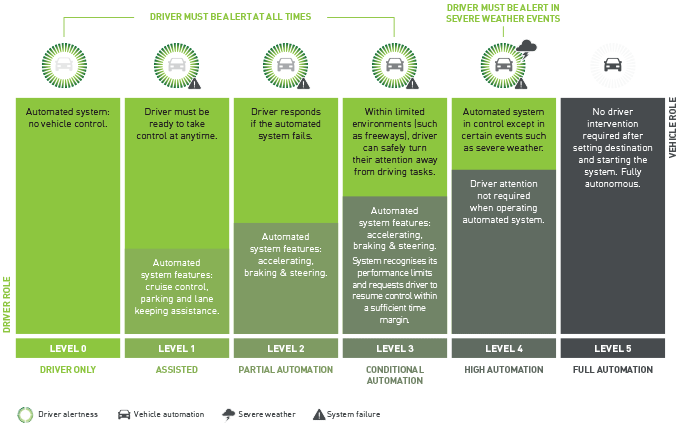Semi-autonomous vehicles are real: self-driving Volvos are already on Swedish roads and will be commercially available next year, while in 2014, Tesla released their autopilot feature on their Tesla S model, which is being used on US highways. But what is meant by a “semi-autonomous” vehicle?
The Society of Automotive Engineers (SAE), an automotive standards body, has defined 6 levels of autonomous vehicles based on how attentive the driver needs to be.
SAE automated vehicle classifications:

In May a Tesla S owner was filmed apparently sleeping at the wheel whilst the car drove itself in busy highway traffic. The YouTube video has racked up over 2.5 million views. The Tesla S is a Level 2 or Level 3 vehicle and therefore the driver needs to be alert and ready to take control of the vehicle at any moment.
The question that comes to mind is whether someone is more likely to fall asleep when the vehicle is on autopilot or not?
Falling asleep at the wheel
People fall asleep at the wheel every day.
Fortunately, a fatality does not occur every time a person falls asleep at the wheel. In fact an accident does not even occur every time someone falls asleep at the wheel.
However, between 20-30% of all vehicle accidents are attributed to a driver falling asleep. You can only imagine how many times a day people are falling asleep at the wheel all over the world.
One of the most common reasons a driver will fall asleep at the wheel is that they have been awake for too long.
In other cases, a driver may have had a good night’s sleep, but while driving down a long and unchanging road, a long period of monotony becomes a catalyst in falling asleep.
There are two mechanisms at play in your brain that determine if you are likely to fall asleep at the wheel.
Competing mechanisms: chemical build-up vs. mental activity
We are all familiar with both mechanisms.
Chemical build-ups occur when you have been awake for too long. From the moment you wake, the levels of a chemical called Adenosine slowly increase in your brain. As the level increases, you start to feel tired. Eventually, sleep will catch up with you.
Simultaneously, there is a competing brain mechanism: your level of arousal, which can change dramatically throughout the day. Factors that affect your arousal levels include your environment, your core body temperature, circadian rhythm, and the mental and physical activities you are performing.
For example, if two people who have had the same amount of sleep watch a movie each – one person watches a boring movie and the other watches an action movie, the person watching the boring movie is much more likely to fall asleep.
Autopilot
Autopilot has one key function: it removes the need for a driver to be actively engaged while a vehicle is moving. However, according to the levels of autonomous driving listed above, classifications named as level one, two or three still require a driver to be alert and aware of his surroundings.
In an urban environment when you are in direct control of a vehicle, you are constantly checking for traffic signals, predicting what other cars are going to do, and shifting your vision between the road, other cars, pedestrians, your mirrors, and your dashboard.
All these actions increase your cognitive load and can help keep you alert, but autopilot removes the need to do these things, and that can lead to cognitive underload. Your natural drowsiness state (based on how much sleep you have had) is now in danger of dominating.
Then… an error or emergency occurs
Imagine you are driving a car with autopilot. In an instance where autopilot needs to hand control back to you, it’s likely that something has occurred that the autopilot cannot handle.
It might be that the software has lost track of lane markings or there is an upcoming obstacle that it cannot identify or safely avoid.
At this exact moment, you need to be alert and ready to take back control.
If you have been subjected to a prolonged period of mental underload, you may experience signs of drowsiness, which means your reaction time is impaired during a period where it needs to be immediate.
Autopilot with drowsiness detection
If there was a way for a vehicle to detect if a driver was alert and capable of taking control of the car, then different actions could be taken. For example, if the driver was asleep, the car could execute a controlled stop and alert the driver to wake up before an emergency occurs.
If the vehicle could detect that a driver is showing the early signs of drowsiness, it could become more responsive and take earlier action in instances where control needs to be returned to the driver.
Engage autopilot and keep your brain engaged
A car with autopilot and a method for determining your drowsiness could actively keep you alert.
Such a system that detects the early signs of drowsiness could start taking anticipatory actions, including the following short-term solutions:
- Reduce the car temperature
- Turn on the radio
- Open the windows
- Provide visual feedback on the surrounding conditions to keep your brain engaged
The above solutions will only provide a short-term improvement, but an even better method to improve alertness is audible and visual stimulation, such as engaging in conversation. A vehicle could ask you about your surroundings (“Do you see the large truck in front of us? What colour is it?”) and require you to respond verbally (“Yes. It is white.”)
It could also prepare you a cup of coffee, and eventually, if you are too drowsy, alter your route to the nearest safe rest stop. Cars with integrated GPS already detect when you fuel is low and start to display petrol stations on the GPS screen, so why couldn’t a vehicle with quantified drowsiness measurement technology display rest-stop suggestions on its screen? There’s no reason a semi-autonomous car couldn’t reroute you to one of these stops when you are reaching a dangerous level of drowsiness.
How does Optalert fit in?
Optalert provides the world’s only quantifiable drowsiness detection technology. The continuous JDS™ scale ranks a driver’s level of drowsiness from zero to 10, where zero = alert and 10 = drowsy.
The fact that the JDS™ scale is quantified means that the vehicle can now take actions to make sure you are alert when you need to be:
- Registered a score of 2? The car’s temperature is dropped by three degrees and the radio is automatically turned on.
- Crept up to a score of 3? The windows are opened to let in fresh air and the car brews you a cup of coffee.
- Nearing a score of 4? The car warns that you are approaching the dangerous state of drowsiness and reroutes you to the nearest safe rest stop for a power nap.
Autopilot without these features is leaving you vulnerable to mental underload and the increased risk that you will not be able to react when you really need to. Otherwise, we can just keep our heads in the sand as we remain asleep at the wheel.

